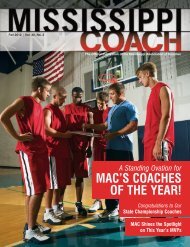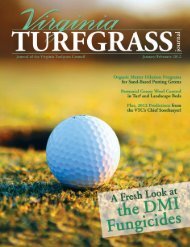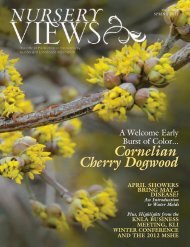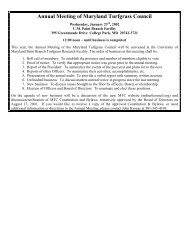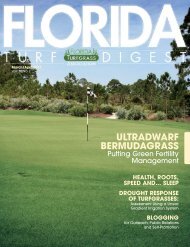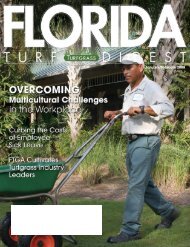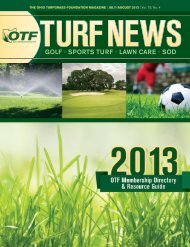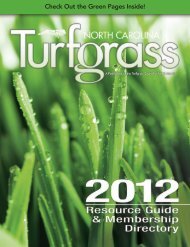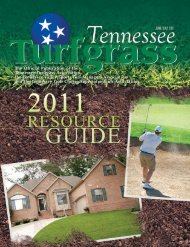November/December 2010 - Powered By The Paginator
November/December 2010 - Powered By The Paginator
November/December 2010 - Powered By The Paginator
You also want an ePaper? Increase the reach of your titles
YUMPU automatically turns print PDFs into web optimized ePapers that Google loves.
<strong>November</strong>/<strong>December</strong> <strong>2010</strong><br />
VOL. 27/NO. 6
Official Journal of the Florida Turfgrass Association<br />
table of contents<br />
<strong>November</strong>/<strong>December</strong> <strong>2010</strong><br />
VOL. 27/NO. 6<br />
Cover Story<br />
Business Matters<br />
Landscaping<br />
<strong>The</strong> Stimpmeter:<br />
Friend or Foe?<br />
12<br />
Managing Up AND Down<br />
For Long-term<br />
Career Success<br />
18<br />
Transitioning to<br />
Florida-Friendly<br />
Landscape<br />
24<br />
More Features<br />
Recent Events<br />
FTGA 58th Annual Conference & Show Travelogue .......................................... 28<br />
Future Turfgrass Leaders<br />
<strong>2010</strong> FTGA Scholarship Recipients ...................................................................... 34<br />
Honors & Awards<br />
Matthew R Taylor, CGCS Awarded Wreath of Grass ............................................ 36<br />
Departments<br />
Editor’s Corner ............................................................................................................ 6<br />
President’s Message ...................................................................................................... 8<br />
From the Executive Director ...................................................................................... 10<br />
Welcome New Members ............................................................................................ 11<br />
Index of Advertisers .................................................................................................. 38<br />
EDITOR-IN-CHIEF Darren J. Davis<br />
PUBLISHER Leading Edge Communications<br />
MANAGING EDITOR MJ Plaster<br />
TECHNICAL ADVISOR J. Bryan Unruh, Ph.D.<br />
www.ftga.org<br />
4 florida turf digest • november/december <strong>2010</strong><br />
Cover photo courtesy of Darren J. Davis.<br />
<strong>The</strong> Florida Turfgrass Association (FTGA)<br />
serves its members in the industry through<br />
education, promotion and representation.<br />
<strong>The</strong> statements and opinions expressed<br />
herein are those of the individual authors<br />
and do not necessarily represent the views<br />
of the association, its staff, or its board of<br />
directors, Florida Turf Digest, or its editors.<br />
Likewise, the appearance of advertisers, or<br />
FTGA members, does not constitute an<br />
endorsement of the products or services<br />
featured in this, past or subsequent issues of<br />
this bimonthly publication. Copyright ©<strong>2010</strong><br />
by the FTGA. Florida Turf Digest, is published<br />
bimonthly. Subscriptions are complimentary<br />
to FTGA members. POSTMASTER: Send<br />
change of address notification to FTGA, 120<br />
East Pine Street, Suite 1, Lakeland, FL 33801.<br />
Postage guaranteed. Presorted standard<br />
postage is paid at Nashville, TN. Printed in the<br />
U.S.A. Reprints and Submissions: Florida Turf<br />
Digest, allows reprinting of material published<br />
here. Permission requests should be directed to<br />
the FTGA. We are not responsible for unsolicited<br />
freelance manuscripts and photographs.<br />
Contact the managing editor for contribution<br />
information. Advertising: For display and<br />
classified advertising rates and insertions, please<br />
contact Leading Edge Communications, LLC,<br />
206 Bridge Street, Franklin, TN 37064,<br />
(615) 790-3718, Fax (615) 794-4524.
Editor’s Corner<br />
<strong>By</strong> Darren J. Davis,<br />
Editor-in-Chief<br />
On My Turf<br />
“TOOTING YOUR HORN”<br />
O<br />
nce upon a time, an elephant was floating<br />
lazily down a winding river when he<br />
spotted a mouse clinging for dear life to<br />
a drawbridge. As the elephant floated<br />
closer, the mouse dropped into the river from<br />
exhaustion. <strong>The</strong> elephant was raised in the area<br />
and knew the current was dangerously swift in this<br />
section of the river and that the mouse was in grave<br />
trouble. He sprang into action and set out to rescue<br />
the mouse. Unable to float under the approaching<br />
drawbridge, the elephant belted out a warning with<br />
his trunk. <strong>The</strong> drawbridge attendant heard the<br />
“horn” and raised the bridge just in time for the<br />
elephant to slide under and scoop up the mouse.<br />
Although panicked, the mouse was aware of the<br />
elephant’s valiant effort and was very grateful. With<br />
the mouse riding safely on the elephant’s belly and<br />
his strength returning, the two drifted down the river<br />
nonchalantly, becoming friends. After a while, the<br />
elephant spotted another drawbridge, but the<br />
elephant knew this one was just high enough that<br />
HE could barely squeak under it (no pun intended).<br />
Unfortunately, by the time the mouse realized the<br />
elephant was not going to use his trunk to signal the<br />
drawbridge attendant to raise the bridge, it was too<br />
late and the mouse bumped his head on the bridge<br />
and fell into the river.<br />
Rested and capable of swimming to shore, the<br />
bewildered mouse swam after the elephant instead.<br />
He asked his newfound friend why he didn’t blow<br />
his trunk like a horn to signal the drawbridge attendant<br />
so he also could have drifted safely under the<br />
bridge. <strong>The</strong> elephant looked at the mouse and<br />
said, “My friend, you will learn there are times in<br />
life that you just have to toot your own horn.”<br />
When I was 10 years old and warming the bench<br />
on the Pee Wee football team, my father told me this<br />
story. My father and I both believed that I deserved<br />
some playing time, but I didn’t know how to get the<br />
coach’s attention. My father used the fable to teach<br />
me that sometimes in life you do have to “toot your<br />
own horn” to gain attention. Many years have gone<br />
by since I was told the story and I am not a parent<br />
myself, but I have used the story on several occasions<br />
when mentoring young turfgrass professionals.<br />
At first glance, it may seem a contradiction that<br />
I emphatically believe that it’s better to be humble<br />
than haughty. Humility is a virtue with biblical and<br />
spiritual roots, and I can appreciate why in some<br />
cultures, it’s considered a core value. Early in life<br />
most are taught humility; in part, because as children<br />
or young adults, we have not honed our interpersonal<br />
communication skills, and our parents or<br />
mentors are aware that if we are perceived as conceited<br />
or arrogant, we will be less likely to develop<br />
successful relationships. <strong>The</strong> challenge many face<br />
is how to balance or merge humility with the need<br />
to promote one’s self in the workplace. Often, we<br />
are taught the value of “dressing to impress” and the<br />
importance of effective writing skills to gain attention,<br />
but there is very little instruction available on how<br />
to be effective at self-promotion.<br />
Understandably, the thought of “tooting your own<br />
horn” can be perceived negatively. However, if you<br />
think of it in terms of becoming more of who you<br />
are and bringing forward your most positive attributes<br />
with genuine pride and enthusiasm, “tooting<br />
your own horn” in the workplace is a method of selfpromotion<br />
that allows you to communicate your<br />
value and showcase your strengths to your employer.<br />
Turfgrass professionals sometimes fall into the role<br />
of the mouse, because of a mindset that our work<br />
will speak for itself. Times have changed! No longer<br />
can we take for granted that job security will be<br />
obtained in exchange for loyalty and hard work.<br />
In today’s unstable and unpredictable workplace,<br />
too often we fail to recognize the importance of<br />
self-promotion. Businesses are merging, restructuring,<br />
and many are downsizing. It is vital that our<br />
employers become aware of our accomplishments<br />
and our value to the business. It’s also important<br />
to let others within the organization know who we<br />
are and what we do. I have seen individuals develop<br />
an effective and productive relationship with their<br />
direct employer, but fail to extend their communication<br />
and self-promotion to others within the<br />
organization. In several instances when something<br />
happened to the employer, the dedicated employee<br />
became unemployed.<br />
It’s too late to start “tooting your own horn” when<br />
you’re in crisis mode, because, like the mouse in<br />
the story, you might find yourself bumping your<br />
head. <strong>The</strong> time to communicate your value to<br />
your employer is today. In this issue, you’ll find an<br />
excellent article, “Managing UP and Managing<br />
DOWN for Long-term Success” by Lyne Tumlinson<br />
that addresses many of these same thoughts. Be<br />
sure to give it a read. ❂<br />
6 florida turf digest • november/december <strong>2010</strong>
Florida Turf Digest is the<br />
official publication of the<br />
Florida Turfgrass Association<br />
120 East Pine Street<br />
Suite 1<br />
Lakeland, FL 33801<br />
(800) 882-6721 or<br />
(863) 688-9413<br />
Fax: (863) 688-9610<br />
info@ftga.org<br />
www.ftga.org<br />
Published by<br />
Leading Edge Communications<br />
206 Bridge Street<br />
Franklin, TN 37064<br />
(615) 790-3718<br />
Fax: (615) 794-4524<br />
info@leadingedge<br />
communications.com<br />
FTGA Executive Director<br />
Pete Snyder<br />
pete@ftga.org<br />
FTGA Marketing & Events Coordinator<br />
Heather Russo<br />
heather@ftga.org<br />
FTGA EXECUTIVE COMMITTEE<br />
President<br />
Mac Carraway<br />
SMR Farms, LLC<br />
(941) 708-3322<br />
mac.carraway@smrfarms.com<br />
Vice President<br />
Armando Campos, CCA, CTP<br />
Nutrient Technologies, LLC<br />
(407) 610-7563<br />
acampos2009@cfl.rr.com<br />
Secretary/Treasurer<br />
Mac Briley<br />
City of Ocoee<br />
(407) 905-3100<br />
abriley@ci.ocoee.fl.us<br />
Immediate Past President<br />
Gregory A. Pheneger<br />
John’s Island Club<br />
(772) 231-1700<br />
gregp@johnsislandclub.org<br />
florida turfgrass association • www.ftga.org<br />
7
President’s Message<br />
OFF AND<br />
RUNNING<br />
<strong>By</strong> Mac Carraway,<br />
FTGA President<br />
As<br />
the incoming president of the Florida<br />
Turfgrass Association, I feel like I have<br />
about 30 seconds to stop and reflect<br />
on the coming year and what needs to<br />
be done. As you know from reading this excellent<br />
magazine, life in the turfgrass industry is a fast-moving<br />
and challenging proposition these days, and the<br />
FTGA is right in the thick of things. A few of the key<br />
drivers for our efforts this year, most of which will<br />
be familiar to you, are…<br />
• Defeating Amendment 4 at the ballot box in<br />
<strong>November</strong>: This job-killing special-interest nightmare<br />
of a constitutional amendment is still poorly<br />
understood and is a clear and present danger<br />
to all of the green industries. This amendment<br />
requires a voter referendum on each and every<br />
change in any community’s comprehensive plan—<br />
a prescription for economic stagnation. If you liked<br />
the recession, you’ll love Florida in the post-A4<br />
world. Please “Vote No on 4,” and encourage<br />
others to do the same.<br />
• Bringing science and common sense to the table:<br />
Some local governments, under pressure from<br />
highly organized activists, have embarked on a<br />
journey of demonizing turfgrass and turfgrass<br />
management—in other words, our way of life. So<br />
far, they have been pretty successful—but the time<br />
is always right to push back. Using arguments that<br />
are contrary to a broad body of research and<br />
exploiting emotional reactions from those who<br />
might be looking for a principled discussion, these<br />
activists want to eliminate managed turf from the<br />
urban landscape. Often lost in the discussion are<br />
the facts that turfgrasses create clear environmental<br />
benefits; that our industries, taken together, are<br />
responsible for game-changing management practices<br />
and products that have reduced irrigation<br />
and improved water quality in Florida’s interior<br />
and coastal waters; and that the real culprits that<br />
remain are overwatering and overfertilizing, best<br />
addressed by education and research, both of<br />
which are at the core of the FTGA’s mission.<br />
• Growing the FTGA: From the first time I attended<br />
a Conference & Show, I could tell that there was<br />
something different about the FTGA. Our longtime<br />
Editor-in-Chief Darren Davis calls it the “passion.”<br />
It is an urgent desire for the FTGA to continue its<br />
legacy of education and research, to take on our<br />
opponents in vigorous advocacy, to strengthen the<br />
critical relationships represented on our board of<br />
directors and in the membership it represents,<br />
and maybe best of all, to put on a relevant and<br />
enjoyable Conference & Show, where we all can<br />
network, catch up with old friends and make new<br />
ones, learn, celebrate our industry, and yes, even<br />
have a little fun (unless you are the Conference<br />
& Show chairman, like your new Vice President<br />
Armando Campos — NO FUN FOR YOU<br />
ARMANDO). Accomplishing these objectives takes<br />
a couple of basic elements. First and foremost is<br />
YOU. Active and passionate membership is the<br />
thing YOUR association needs most from you. I<br />
hope you will always find the time to keep up with<br />
what the FTGA is doing, and to support us with<br />
your time and money—which is the perfect segue<br />
to the second basic element, which is fund raising.<br />
As you know, we live on the net income from dues,<br />
Conference & Show and Turf Seminars. Please<br />
support these efforts and encourage others to<br />
join and support us as well!<br />
I cannot end this conversation without saying<br />
thank you for the very humbling opportunity to<br />
serve you this year. While many of you may not know<br />
me or may not know me well, I will pledge to you a<br />
year of effort and listening. If you have something<br />
you would like to share with me, please send me<br />
an e-mail at mac.carraway@smrfarms.com, and put<br />
IMPORTANT FTGA BUSINESS in the subject line.<br />
While I do have a day job like the rest of you, I will<br />
do my best to respond to you in a timely way.<br />
Finally, I want to thank my predecessor, Greg<br />
Pheneger, for an excellent year as your president. I<br />
will repeat what I said at our recent annual meeting,<br />
which is that Greg conducted his year with class and<br />
enthusiasm, proving himself a leader and friend to<br />
all of us in this great association. Many thanks also<br />
to those other FTGA presidents I have served with on<br />
the board—Jay McCord, Matt Taylor, Darren Davis<br />
and Todd Himelberger. It has been my privilege.<br />
Talk to you soon. ❂<br />
8 florida turf digest • november/december <strong>2010</strong>
FTGA Directors<br />
Jan Bel Jan<br />
Jan Bel Jan Green Designs<br />
(561) 371-0397<br />
beljanj@bellsouth.net<br />
Eric A Brown, Ph.D.<br />
Massey Services, Inc.<br />
(352) 514-9233<br />
eric@turfgrassdoctors.com<br />
Robby Clemenzi<br />
Bayer Environmental Sciences<br />
(352) 494-2552<br />
Robby.Clemenzi@Bayer.com<br />
Darren J. Davis<br />
Olde Florida Golf Club<br />
(239) 353-4441<br />
darrenjdavis@aol.com<br />
William T. Hiers, CGCS<br />
<strong>The</strong> Old Collier Golf Club<br />
(239) 593-8522<br />
thiers@theoldcolliergc.com<br />
Todd J. Himelberger<br />
DuPont Professional Products<br />
(941) 685-6793<br />
todd.j.himelberger@usa.dupont.com<br />
Al Hoffer<br />
Al Hoffer’s Termite-Lawn-Pest<br />
(954) 753-1222<br />
al@alhoffer.com<br />
Mark Kann<br />
University of Florida<br />
(352) 591-2678<br />
mkann@ufl.edu<br />
William Lanthier<br />
Golf Ventures<br />
(772) 486-1701<br />
blanthier@golfv.com<br />
John Mascaro<br />
Turf-Tec International<br />
(850) 580-4026<br />
john@turf-tec.com<br />
Betsy McGill<br />
Florida Sod Growers Cooperative<br />
(863) 675-2144<br />
flsodgrowers@aol.com<br />
Matt Shook<br />
Harrell’s Fertilizer<br />
(863) 687-2774<br />
mshook@harrells.com<br />
Frank Warden<br />
<strong>The</strong> TORO Company<br />
(850) 776-6925<br />
frank.warden@toro.com<br />
Kevin Wasilewski<br />
Syngenta Professional Products<br />
(863) 644-1467<br />
kevin.wasilewski@syngenta.com<br />
Stacie Zinn<br />
Environmental Turf, Inc.<br />
(863) 452-6595<br />
stacie@environmentalturf.com<br />
florida turfgrass association • www.ftga.org<br />
9
From the Executive Director<br />
Building<br />
“Mo”<br />
<strong>By</strong> Pete Snyder,<br />
FTGA Executive<br />
Director<br />
FTGA<br />
has momentum—<br />
we have “the buzz”<br />
back. That’s what<br />
most attendees at<br />
this year’s Conference & Show have said. Certainly<br />
the numbers would support the “mo” label.<br />
Late registrations made planning difficult. Still,<br />
rooms were a sellout, despite increasing our allotment<br />
twice. Trade Show booth space was a sellout.<br />
Many educational sessions were packed beyond<br />
capacity. Additional seating had to be added to both<br />
lunches and to the Corn Boil. After-hours activities<br />
had Curly and Larry joining “mo,” but that’s a different<br />
issue (what happens at the C&S stays at the C&S).<br />
We issued over 625 badges, of which less than 175<br />
were for exhibitors, students and academics—suggesting<br />
that more than 450 active turfgrass professionals<br />
took part in our activities. Thursday’s allattendee<br />
lunch had well over 600 people, who also<br />
packed the Trade Show floor for its initial hours.<br />
True momentum is based on continuous improvement<br />
and making sure that we are meeting or<br />
exceeding the expectations of all industry sectors<br />
and categories of FTGA membership. We intend<br />
to survey attendees again this year to see what<br />
worked and what could be made better. Once compiled,<br />
the survey results will be shared with the<br />
FTGA membership.<br />
Momentum is also measured in FTGA membership<br />
numbers. Modest gains were made in <strong>2010</strong>,<br />
but they fell short of the bar we set. We met the<br />
new member goal, but membership retention was<br />
down to about 84% versus an earlier lofty 96%<br />
retention rate goal. Clearly we need to improve<br />
our value proposition.<br />
Over the past year, the Membership Services Committee,<br />
under the leadership of Mac Briley, the<br />
FTGA’s newly elected secretary/treasurer, developed<br />
an entirely new membership structure that the<br />
FTGA board of directors approved at the June<br />
board meeting.<br />
Under the new structure, both corporate and<br />
individual memberships will be available. Previously,<br />
all memberships were individual and moved with<br />
the individual from job to job.<br />
Individual membership categories have been<br />
revised. <strong>The</strong> “Active” and “Associate” (out-of-state<br />
members) memberships remain as they always have<br />
been at $190 per year. However, the “Affiliate” (an<br />
employee of an active or associate member) member<br />
charge has been reduced from $90 to $75 per year.<br />
During the Annual Meeting at the C&S, a new<br />
“Technician” member category was voted into our<br />
bylaws. It will also be $75 per year. <strong>The</strong> “Student”<br />
membership category will remain at $35 per year,<br />
and the “Retired” membership category will be<br />
reduced from $50 to $35 per year.<br />
Corporate membership (wherein the membership<br />
will be held in the corporate or organizational<br />
name) will be priced at $190 per year for one person.<br />
<strong>The</strong> next four employees from a corporate/<br />
organizational group will be priced at $75 per year<br />
each. Employee six and beyond will be priced at<br />
$50 each per year.<br />
Corporations will also be able to take advantage<br />
of “Partner Recognition Sponsorship” (PRS) plans,<br />
which provide up-front, all-inclusive pricing for all<br />
FTGA offerings—from FTGA memberships and<br />
event participation, to FTGA advertising and sponsorships.<br />
<strong>The</strong>se plans are ideal for the company that<br />
is looking to budget a year’s worth of programming<br />
at once.<br />
<strong>The</strong>re are five different PRS plans (bronze, silver,<br />
gold, platinum and diamond) that range in price<br />
from $3,500 to $30,000 per year for discounts that<br />
range from 10% to over 20% for the more robust<br />
plans over a la carte pricing. In addition, discounts<br />
will be offered for up-front payments in whole or in<br />
part. Each plan offers a menu of opportunities within<br />
the price-value range from which a corporation<br />
may choose.<br />
New membership categories and pricing are half<br />
of the FTGA’s value proposition. We are intent on<br />
providing superior value to our existing benefits,<br />
while adding new membership benefits, such as<br />
Sam’s Club memberships and hotel and rental car<br />
discount programs. Stay tuned. <strong>The</strong> “mo” will<br />
continue to build. ❂<br />
10 florida turf digest • november/december <strong>2010</strong>
Welcome New<br />
FTGA Members!<br />
Keith Andrews<br />
DSG Fleet Solutions<br />
John Brown<br />
NewLife Turf, Inc.<br />
Dr. Max Brown<br />
Eco Verde Technologies, Inc.<br />
Billy Browning<br />
Harrell’s Fertilizer<br />
Chad Chrissman<br />
Village of Wellington<br />
Jack Conroy<br />
Monsanto Company<br />
Jason Craft<br />
<strong>The</strong> Sanctuary Golf Club<br />
Brian Darby<br />
Unique Turf, Inc.<br />
Tony Davis<br />
Solid Waste Authority of<br />
Palm Beach County<br />
Michael Gans<br />
Pathway Holdings<br />
Vinnie Inguaggiato<br />
Solid Waste Authority of<br />
Palm Beach County<br />
Gary L. McCall<br />
Manatee County<br />
Kevin Meredith<br />
Key Plex<br />
Keith Montgomery<br />
Select Source<br />
Christopher Neff<br />
Timuquana Country Club<br />
Darryl Rejko<br />
Links Systems<br />
Kevin Sheaffer<br />
Dow AgroSciences<br />
Elizabeth Smith<br />
Resource Partners Enterprises, LLC<br />
Andrew Taylor<br />
McCall Service, Inc.<br />
Geoffrey Vaughan<br />
Village of Wellington<br />
Steven Williams<br />
Knight Management, Inc.<br />
Kym Wood<br />
Parkway Research
Cover Story<br />
12 florida turf digest • november/december <strong>2010</strong>
<strong>By</strong> Darin S. Bevard<br />
Editor’s Note: In Florida, the busy winter golf season is upon us, and at most courses, green speed is again a topic of daily conversation. Green<br />
speed, and the pressure to continually provide faster and faster greens, can be a source of great trepidation for golf course superintendents. Whether<br />
or not to measure green speed can also produce apprehension and anxiety. Since its inception, the Stimpmeter, the tool used to measure green<br />
speed, has created lively debate. In 2007, my club president issued a directive that I would begin using the Stimpmeter on a daily basis. Up to<br />
this point in my career, I was of the opinion that the Stimpmeter was my “foe,” and the command from my employer, who is a very hands-off<br />
individual, surprised me and truthfully produced a considerably amount of stress for me. However, after several seasons of daily use, I now<br />
consider the Stimpmeter my “friend.” Recently, I came across an article written by USGA Agronomist, Darin Bevard. <strong>The</strong> article was published<br />
online in the October 29, <strong>2010</strong>, Green Section Record Vol. 48 (21) and addresses the question, “<strong>The</strong> Stimpmeter: Friend or Foe?” As the author<br />
depicts it, it can be a love/hate relationship. I have learned to not intervene in issues of love or politics with my friends and peers, but I found<br />
the author spot on in his analysis and thought others might benefit from his analysis and opinions.<br />
<strong>The</strong><br />
love/hate relationship<br />
between<br />
golf course superintendents<br />
and<br />
the Stimpmeter continues, but could<br />
this tool actually be your best friend?<br />
Ever since the USGA completed development<br />
of the Stimpmeter in 1976 and<br />
the tool was made available to superintendents<br />
and course officials in 1978,<br />
controversy has ensued. Definitely, the<br />
Stimpmeter changed the way golf greens<br />
are compared. In the 1930s, Edward<br />
Stimpson invented the tool that would<br />
eventually become the Stimpmeter,<br />
designed to monitor green speeds on a<br />
golf course to improve its consistency.<br />
It seems that the modern Stimpmeter<br />
frequently is used to see who can produce<br />
the fastest greens, and these speeds<br />
are now a point of comparison (and<br />
often envy) from golf course to golf<br />
course. Many superintendents refuse<br />
to “Stimp” their greens, shunning all<br />
things Stimpmeter. In fact, I once saw<br />
a Stimpmeter planted in a five gallon<br />
bucket of concrete. Talk about making<br />
a point! But what if the Stimpmeter<br />
could be used for good, as a weapon<br />
against excessive green speed? Perhaps<br />
florida turfgrass association • www.ftga.org<br />
13
Cover Story<br />
the superintendent who pulled the<br />
weapon from the concrete could experience<br />
Camelot. Well, probably not, but<br />
read on.<br />
First, it is important to recognize what<br />
that Stimpmeter number represents.<br />
Speed of green is discussed all of the<br />
time. For example, “My buddy played<br />
golf over the weekend, and he said the<br />
greens were rolling 14.” <strong>The</strong>y probably<br />
weren’t. Green speeds are regularly<br />
mentioned on golf telecasts. However,<br />
when golfers are asked what the number<br />
represents or how it is obtained, there is<br />
silence. For the record, the Stimpmeter<br />
value is the average distance the ball rolls<br />
when released from the fixed point on<br />
the tool. Preferably, a virtually flat area<br />
on a green is selected. Three balls are<br />
rolled from the Stimpmeter, and the<br />
average ball roll distance is marked. A<br />
second set of three balls is then rolled<br />
from the marked spot in the opposite<br />
direction of the first roll, and the average<br />
is again noted. <strong>The</strong> two averages are<br />
added together and divided by two to<br />
establish the distance of ball roll in feet<br />
and inches (e.g., greens are rolling 10'<br />
6"). Thus, the Stimpmeter reading is not<br />
a speed at all. It is a distance. However,<br />
in the golf lexicon, this number is equivalent<br />
to the speed of the greens.<br />
Many superintendents do not use the<br />
Stimpmeter for fear of having to post<br />
green speeds (not recommended) or<br />
having to manage their greens to a<br />
number rather than in the interest of<br />
healthy turfgrass. <strong>The</strong>se are valid concerns,<br />
but they can actually be addressed<br />
better by using the Stimpmeter, rather<br />
than not using it. Golfers (of which<br />
I am one) are a fickle bunch. <strong>The</strong><br />
perceived speed and quality of greens<br />
is often more affected by a particular<br />
golfer’s experience on a given day<br />
rather than the actual condition of the<br />
greens. Common comments include, “I<br />
didn’t putt well today. <strong>The</strong> greens were<br />
slow.” Or, “I made everything today, the<br />
greens were just the way I like them.”<br />
In terms of green speed, knowing the<br />
speed of greens helps to remove emotion<br />
from the equation when evaluating<br />
the condition of the greens and ultimately<br />
the performance of the golf<br />
course superintendent.<br />
A big problem for golf course superintendents<br />
is golfer desire to have faster<br />
greens. Many times, the current speed<br />
of greens is not even considered. Rather,<br />
the greens just need to be faster, faster,<br />
faster. This becomes a contentious issue<br />
and can lead to problems. What if the<br />
greens are already pretty fast for daily<br />
play? Generally, as green speeds increase,<br />
so does the chance of stress to the turfgrass.<br />
How fast is too fast? <strong>The</strong> answer<br />
varies. Some facilities have the available<br />
resources to maintain very fast greens<br />
consistently, but most have to establish<br />
a reasonable daily speed target that is<br />
obtainable given available resources and<br />
grass composition, with the understanding<br />
that some portions of the growing<br />
season are not conducive to faster<br />
greens. Do not be fooled. Available<br />
resources are a big factor in maintaining<br />
green speed.<br />
In recent years, golfers have trended<br />
towards more consistent daily green<br />
speeds without severe peaks and valleys,<br />
depending upon the day of the week.<br />
<strong>The</strong> practice of ramping up green speed<br />
for the weekend through aggressive<br />
grooming and maintenance, and then<br />
backing off during the week, creates<br />
more problems with green speed. Consider<br />
your average golfer. On Saturday,<br />
this golfer tees off during the morning<br />
hours and putts on greens that were<br />
just prepared for play. During the week,<br />
this same golfer may not tee off until<br />
after work, when the greens have been<br />
growing all day. If the greens were<br />
ramped up for the weekend, the disparity<br />
in speed for weekend and weekday<br />
play can be dramatic. This leads<br />
to complaints of inconsistent or slow<br />
greens during the week. Maintaining<br />
consistent, well-paced greens on a daily<br />
basis is becoming more common.<br />
So how does the Stimpmeter fit into<br />
this context? <strong>The</strong> Stimpmeter provides<br />
knowledge, and knowledge is powerful.<br />
<strong>The</strong> first step to this process is to determine<br />
a reasonable daily green speed,<br />
taking into account the parameters of<br />
your individual golf course. Once this<br />
standard is established, efforts can<br />
be geared towards maintaining the<br />
standard. Keep in mind that if the<br />
14 florida turf digest • november/december <strong>2010</strong>
Cover Story<br />
standard is reasonable for your golf<br />
course situation, by definition, the health<br />
of the turfgrass will not be compromised.<br />
Some understanding of stressful times<br />
of the growing season for your area is<br />
required, as well. Stimpmeter readings<br />
should be taken frequently to monitor<br />
green speed. This is an extra chore. With<br />
the knowledge of the actual speed, an<br />
educated conversation can be conducted<br />
about the greens. Similar areas should<br />
be tested by the same person to eliminate<br />
variability in measurements. So<br />
long as all parties involved know the<br />
standard, posting of green speed is not<br />
necessary or recommended. If a golfer<br />
complains about slow greens, the answer<br />
may be as simple as explaining that the<br />
green speed has been the same for<br />
several days. Perhaps the greens are<br />
slower. Knowing this fact provides the<br />
opportunity to explain the factors that<br />
are affecting speeds. Maybe the greens<br />
were not rolled in the interest of time,<br />
or a heavy irrigation or rainfall occurred<br />
that prompted mowing to be skipped. If<br />
you do not know the actual green speed,<br />
your performance may be evaluated<br />
based upon the whims of a golfer who<br />
had a bad day rather than the actual<br />
conditions that are present.<br />
If you are one of the fortunate few<br />
who do not receive pressure for faster<br />
greens, count your blessings. For most,<br />
green speed is one of the biggest points<br />
of comparison between golf courses. In<br />
fact, for some, speed of greens and their<br />
overall condition is the biggest factor in<br />
the evaluation of golf course conditioning.<br />
Using the Stimpmeter to measure<br />
green speed provides an opportunity<br />
to educate golfers about what is being<br />
achieved on the greens on a daily basis.<br />
This solution may not be necessary for<br />
everyone, but the Stimpmeter can take<br />
the guesswork out of daily green speeds.<br />
How can the speed of greens be discussed<br />
if you do not know how fast they<br />
are? <strong>The</strong>y cannot. In this regard, the<br />
Stimpmeter is definitely your friend! ❂<br />
Darin S. Bevard is a senior agronomist from<br />
the USGA Mid-Atlantic Region, where green<br />
speed is a regular topic of conversation, as<br />
it is throughout the golf industry.<br />
16 florida turf digest • november/december <strong>2010</strong>
Business Matters<br />
<strong>By</strong> Lyne Tumlinson, Career Lift, LLC<br />
T<br />
his summer was certainly a<br />
tough one for Florida turf<br />
managers with the continuing<br />
economic challenges complicating<br />
the specter of job security. No<br />
one should be surprised if you are a<br />
little grumpier these days!<br />
Twenty-first-century careers—not<br />
only in the turf business but throughout<br />
the entire business community—have<br />
become adventures with a new map for<br />
careers, including challenges with coworkers.<br />
<strong>The</strong> basic principles for career<br />
success remain the same, however,<br />
with a few fresh twists to maneuver<br />
on the way.<br />
Here’s a quick review of some best<br />
practices in “managing UP” to those<br />
you report to and “managing DOWN”<br />
to those who report to you, with an aim<br />
of keeping the peace in your workplace<br />
and building success. As you read, if<br />
you find yourself thinking you’ll adapt<br />
these practices when you have time,<br />
things will never improve. Make the time<br />
starting today: Try setting 10 minutes<br />
each morning to do just one thing differently.<br />
<strong>The</strong>n give yourself time to<br />
practice and learn. Let’s get started!<br />
Principle #1: <strong>The</strong> Platinum<br />
Rule will serve you better<br />
than <strong>The</strong> Golden Rule.<br />
Remember the Golden Rule? “Do unto<br />
others as you would have them do unto<br />
you.” This implies that other people<br />
would like to be treated the way that<br />
you would like to be treated, with the<br />
assumption that all people are the same.<br />
For better results, try <strong>The</strong> Platinum<br />
Rule: “Treat others the way they want to be<br />
treated.” <strong>The</strong> Platinum Rule accommodates<br />
others’ individual preferences.<br />
<strong>The</strong> focus shifts from “this is what I<br />
want, so it must be good for everyone”<br />
to “let me first understand what they<br />
want, so I can deal with others on their<br />
own level.”<br />
<strong>The</strong> Platinum Rule is key to developing<br />
positive relationships for both managing<br />
UP and managing DOWN. Check<br />
out just some of the benefits:<br />
Learning patience with others<br />
Develop patience by asking questions to<br />
dig deeper and better understand your<br />
customers and employer. If you begin by<br />
assuming they are rational people, they<br />
may just prove it to you as you learn<br />
about their expectations and needs.<br />
Gain the “What can I do for you<br />
today?” attitude to welcome feedback,<br />
open communication channels and put<br />
a smile on your employer’s face.<br />
Understanding others’ differences<br />
• Diversity is about more than skin color,<br />
ethnic group or what college you<br />
attended. Cultural differences are<br />
also found among personality types,<br />
management styles, regional origins<br />
and other factors.<br />
• Whether managing up or down, the<br />
key to positive relationships is to<br />
accept that we all have different<br />
strengths and to find ways to utilize<br />
them for everyone’s benefit.<br />
Motivating your workers (who<br />
then make you look good)<br />
If applicable, update your management<br />
style from “Command” (issuing detailed<br />
orders and expecting them to be followed,<br />
no questions asked) to more<br />
Randy Hunt, General Manager and CEO, Milburn Golf & Country Club:<br />
“Stan George, CGCS, golf course superintendent at Prairie<br />
Dunes made my day every morning by coming into my<br />
office and asking me, ‘What can I do for you today?’”<br />
That question demonstrated his attitude of service and<br />
being there for the goals of the overall golf facility, which<br />
went a long ways with me.”<br />
18 florida turf digest • november/december <strong>2010</strong>
“Collaborative” (taking others’ ideas for<br />
how to achieve your goals into consideration)<br />
for a better response from<br />
your employees.<br />
Realize that when an employee follows<br />
your orders without question, you<br />
may get the short-term desired results,<br />
but you give up the possibility of longerterm<br />
commitment, creativity and productivity<br />
from that person. Instead,<br />
when you share the goal of the assignment<br />
and listen to their ideas for carrying<br />
it out, you will see them engaged<br />
in the work, feeling acknowledged and<br />
a valuable part of the team.<br />
<strong>The</strong>re are, of course, exceptional situations<br />
when military style Command<br />
leadership is needed to implement decisions<br />
quickly. Feel free to ask questions<br />
and start discussion about leadership<br />
and management styles for individual<br />
situations.<br />
Using the Platinum Rule, you can<br />
work with your employer, customer<br />
or employee on the end goal. For an<br />
employer, think of focusing on what the<br />
person above him or her wants—is it<br />
bottom-line profit, more players, better<br />
environment or simply to avoid surprising<br />
questions from the public?<br />
As an employer, realize that your<br />
employees need to be acknowledged,<br />
to be heard, to have their point of view<br />
honored—whether or not you agree<br />
with them.<br />
Principle #2: Communicate,<br />
communicate, communicate!<br />
When you’re working your heart out, the<br />
need to explain why you’re doing what<br />
you’re doing can feel like a redundant<br />
step that takes time. It’s tempting to<br />
think that your work should speak<br />
for itself to your customers and your<br />
employers. That may be the case when<br />
the turf looks good, but when times get<br />
hard, it’s a bit late to start creating an<br />
atmosphere of trust and get those folks<br />
behind you.<br />
If you’re behind in developing<br />
open communication lines with your<br />
employer(s), here are some survival<br />
tactics for you to get a quick start:<br />
William Irving, Golf Course Superintendent, Lawrence Country Club:<br />
“Communication is the key to ‘managing up.’ No matter<br />
how busy I am, I make sure to go by our GM’s office one<br />
to two times a week to give him a heads up about what’s<br />
going on out on the course. It’s not fair for him to be<br />
surprised by learning about turf issues from others, and<br />
I also want the opportunity to share the good along with<br />
the bad!”<br />
• Build communication based on the<br />
channel he or she works with best—<br />
whether a note on the desk, an e-<br />
mail, a text message or phone call<br />
(or voice mail).<br />
• If you hear negative rumors about you<br />
or your work, go directly to the source<br />
and clear it up. Yes, it is your job to<br />
start the process. Stay cool, stick with<br />
the facts and be professional.<br />
• Build a positive relationship with your<br />
employers and all their organizational<br />
allies. Again, the more people you<br />
can educate about what you do and<br />
why, the better.<br />
• Never say anything negative about<br />
your employer. If they find out, you<br />
are the troublemaker, no matter<br />
what the context.<br />
• Idea: Share your professional development<br />
plan, include educational<br />
seminars you plan to attend, the costs<br />
florida turfgrass association • www.ftga.org<br />
19
Business Matters<br />
William Irving, Golf Course Superintendent, Lawrence Country Club:<br />
“This week, as we began fertilizing, the weather shifted, so the process<br />
was stopped. <strong>The</strong> next day, the guys picked up the process and<br />
routinely began again at the same point, causing the first green to<br />
get a double dose of fertilizer. <strong>The</strong>y came to me (almost immediately)<br />
with apologies for the mistake, obviously worried that I would go<br />
off on them about it. But what good would that do?<br />
“Mistakes need to be acknowledged and corrected immediately in<br />
order to improve performance, but then let it go. Don’t keep score!<br />
Continually look for positive accomplishments, in order to praise as<br />
much as criticize. Building up those who report to you and helping<br />
them to grow makes the team perform better—and they’re the ones<br />
who make me look good as I answer to the members and my own boss!”<br />
20 florida turf digest • november/december <strong>2010</strong>
and what you expect to learn. <strong>The</strong>n,<br />
detail how the knowledge gained<br />
will directly apply to the goals of<br />
the business.<br />
Principle #3: Make it your<br />
goal to reduce stress both<br />
UP and DOWN.<br />
<strong>The</strong> secret to success is in building relationships<br />
based on the other person’s<br />
goals. <strong>By</strong> helping someone else fulfill<br />
his or her needs, whether employer or<br />
employee, you will be a step closer to<br />
your own success. For managing up,<br />
think in terms of daily challenges your<br />
employer faces: Who are they answering<br />
to, and how can you make them look<br />
good? In the same way, help your<br />
employees make you look good by<br />
clearly communicating your expectations<br />
and recognizing their contributions<br />
to the team’s success.<br />
Either way, take personal responsibility<br />
for the outcomes of your every<br />
decision and action. If you’ve said or<br />
done something wrong or uncalled<br />
for, own up to it and apologize. If<br />
you are put into a vulnerable position<br />
because you admit your blunder, focus<br />
on and share your competencies (skills<br />
and abilities) with a specific plan to<br />
avoid that slip-up in the future.<br />
In summary, for success in managing<br />
UP or managing DOWN, focus on the<br />
goals of the overall business, not only<br />
the pieces of the puzzle that are your<br />
responsibility. If you understand the<br />
entire budget and operational goals, you<br />
can determine where your work fits into<br />
the big picture. Finally, communicate<br />
your willingness to work with the team<br />
for overall success, and your agronomic<br />
prowess will speak for itself. ❂<br />
Lyne Tumlinson is doing business as Career<br />
Lift, LLC. Lyne formerly worked in the<br />
turfgrass industry as GCSAA Director of<br />
Career Services. Currently, she coaches golf<br />
course superintendents and other professionals,<br />
helping them achieve 21st-century career<br />
success. For more information, contact her<br />
at 785-331-6003 or lyne@career-lift.com.
Landscaping<br />
<strong>By</strong> Betsy McGill, Executive Director, Florida Sod Growers Cooperative<br />
If<br />
you sell, install or care for<br />
turfgrass in communities<br />
governed by homeowner or<br />
property owner associations,<br />
you’ve probably already fielded questions<br />
from customers about Florida-<br />
Friendly Landscaping and different turfgrass<br />
varieties generated by last year’s<br />
revisions to what’s now known as the<br />
“Florida-Friendly Landscape Ordinance”<br />
(State Statute 373.185).<br />
This ordinance was originally adopted<br />
in 2001 to require the state’s water management<br />
districts to create model landscape<br />
ordinances for water conservation<br />
that could be adopted by municipalities<br />
and counties within their district. That<br />
version of the ordinance encouraged<br />
using Xeriscape principles and stated<br />
that no covenants or deed restrictions<br />
created after 2001 could prohibit<br />
a homeowner from installing a<br />
xeric landscape.<br />
2009 revisions by the Florida legislature<br />
replaced Xeriscape with “Florida-<br />
Friendly Landscaping” and made it illegal<br />
for any covenant or deed restriction,<br />
24 florida turf digest • november/december <strong>2010</strong>
egardless of when it was enacted, to<br />
prohibit the use of Florida-Friendly<br />
Landscaping. Covenants that required<br />
St. Augustinegrass, for example, can be<br />
successfully challenged by homeowners<br />
who prefer a different variety—or no<br />
grass at all.<br />
<strong>The</strong> changes have left many HOAs<br />
struggling with the daunting task of revising<br />
their governing documents to comply<br />
with the statute while still encouraging<br />
attractive landscapes that support<br />
property values. And while homeowners<br />
are happy to have more choices, most<br />
are unsure about how one turfgrass<br />
differs from another and what best fits<br />
their needs.<br />
<strong>The</strong> key to successfully guiding your<br />
turf business through this transition boils<br />
down one thing: educating yourself so<br />
you can educate your customers.<br />
Understand what<br />
the statute says<br />
A good place to start is with the statute<br />
itself, which can be found online at<br />
www.leg.state.fl.us/Statutes (in the<br />
Search box for 2009 statutes, type<br />
“373.185”). It’s relatively short, and it’s<br />
helpful to understand exactly what it<br />
requires and to be able to direct an<br />
HOA board member or customer to<br />
the statute.<br />
Learn what Florida-<br />
Friendly Landscaping is—<br />
and what it isn’t<br />
While there’s a considerable amount<br />
of confusion about what constitutes a<br />
Florida-Friendly Landscape, one thing<br />
is clear: Florida-Friendly Landscaping<br />
does not mean “no turf.” <strong>The</strong>re is no<br />
“list of approved grasses,” so if an association<br />
or customer asks what’s suitable<br />
for their community, focus on three<br />
things: site conditions, usage and expectations,<br />
and responsible care. Florida-<br />
Friendly Landscaping stresses matching<br />
plants to site conditions and caring for<br />
them responsibly, so any turfgrass that<br />
is suitable for the site and can be maintained<br />
with a reasonable amount of<br />
care is appropriate.<br />
Learn about new grass types<br />
and how to care for them<br />
It’s critical that you make a special effort<br />
to learn about newer varieties, their benefits<br />
and drawbacks, and how to care for<br />
them correctly. Treating zoysia grasses<br />
the way you’ve always handled St.<br />
Augustine can be a recipe for disaster;<br />
responding to a customer inquiry with<br />
a vague answer or blank look will probably<br />
mean a lost sale.<br />
Take advantage of opportunities for<br />
continuing education; for proprietary<br />
grasses (like Empire, JaMur or Ultimate<br />
Zoysia), consult the licensing companies<br />
and the farms that produce them for<br />
more specific information.<br />
Think you can’t afford seminar fees<br />
or the time away from work? Balance<br />
these costs against just one “job gone<br />
wrong,” and you’ll quickly see that investing<br />
in education now will more than pay<br />
for itself by preventing costly callbacks<br />
to deal with problems.<br />
Manage customer<br />
expectations<br />
One of the best ways to ensure a happy<br />
customer is to manage their expectations.<br />
For example, while bahia is certainly<br />
inexpensive, tough and able to<br />
survive on little care, it does have drawbacks.<br />
Bahia’s open growth habit can<br />
invite weeds and will not have the same<br />
dense appearance as a Floratam St.<br />
Augustine lawn. And when the rain stops<br />
or the weather turns cool, bahia and<br />
zoysia grasses will turn brown or yellow<br />
as a natural protection mechanism. A<br />
customer who doesn’t anticipate this may<br />
apply more irrigation water or fertilizer<br />
to restore the green appearance, undermining<br />
the benefits he sought or costing<br />
you valuable time making site visits<br />
for “dead grass.”<br />
Promote responsible<br />
care of landscapes<br />
Lawns have been unfairly criticized for<br />
“wasting water” and requiring huge<br />
amounts of fertilizer and pesticides to<br />
survive. As scientific studies prove otherwise,<br />
care recommendations (like the<br />
watering frequency for new turf establishment<br />
and fertilization needs) have<br />
evolved in response to better information<br />
and environmental concerns. Make<br />
it a priority to get certified in Green<br />
Industries Best Management Practices<br />
and keep up to date on the latest trends.<br />
Don’t let your business be one of those<br />
that reinforces the negative image<br />
of turf.<br />
Carefully chosen and responsibly<br />
maintained turfgrass is not just Florida<br />
Friendly; it’s an asset to Florida’s environment,<br />
providing a long list of scientifically-proven<br />
benefits including filtering<br />
pollutants from water, preventing erosion,<br />
providing oxygen and holding onto<br />
carbon. Be sure your customers know<br />
that they can be Florida Friendly and<br />
still enjoy their lawn, and be sure to educate<br />
yourself so that your business<br />
will thrive as a valuable resource to<br />
your customers. ❂<br />
florida turfgrass association • www.ftga.org<br />
25
Recent Events<br />
FTGA 58th Annual<br />
Conference & Show<br />
Family Travelogue<br />
Live music at the Opening Reception.<br />
W<br />
ow, just WOW! If you missed<br />
this year’s Conference &<br />
Show in Orlando, you really<br />
blew it. This was the best<br />
C&S extravaganza I have ever attended—<br />
outstanding presentations, more people,<br />
more sponsors, more networking opportunities,<br />
more fun in general and specifically<br />
designed to include family members.<br />
<strong>The</strong> mood was decidedly upbeat.<br />
Mrs. FTGA (Lillibelle) and I loaded up<br />
the turfgrassette twins (Fifi and Fiona)<br />
and headed up the Turnpike to Orlando<br />
at oh-dark-hundred on Wednesday. <strong>The</strong><br />
SUV overflowed with DVDs, snacks, sleeping<br />
bags, floats and all manner of justin-case<br />
items that Mrs. FTGA just knew we<br />
couldn’t live without. As we approached<br />
the hotel entrance, the three Sleeping<br />
Beauties sprang into action. Mrs. FTGA<br />
unloaded the twins’ beach bags, while I<br />
checked in and unloaded the SUV.<br />
While they enjoyed the sun and fun, I<br />
attended my morning workshop. <strong>By</strong> the<br />
time I arrived, there was a standing-roomonly<br />
crowd. Still, I was able to absorb all<br />
the great information presented over the<br />
next couple of days. Each day, I would<br />
meet up with the family for networking<br />
events. <strong>The</strong> girls got a kick out of meeting<br />
all of Dad’s friends and colleagues<br />
who made them feel right at home.<br />
While I attended lunch and the Trade<br />
Show, the rest of the family went on an<br />
excursion to the outlet malls. BIG mistake<br />
and big dent in my wallet! <strong>The</strong> high point<br />
for the girls was the outing to Disney.<br />
<strong>The</strong>ir second favorite event was the Corn<br />
Boil-luau night around the pool, followed<br />
by the live auction benefitting the Florida<br />
Turfgrass Research Foundation (FTRF).<br />
<strong>The</strong>y had never seen a live auction, and<br />
they marveled at how anyone could talk<br />
that fast. Mostly they giggled at all the ugly<br />
Hawaiian shirts, snapping photos on their<br />
cell phone to post on their Facebook<br />
page. Who knew that an FTGA C&S would<br />
turn into a memorable family vacation—<br />
something the girls would brag about on<br />
Facebook. We’re all planning to return<br />
next year for an encore, and we hope to<br />
meet up with you and your family. ❂<br />
Greg Pheneger talks with Dwight Kummer.<br />
Darren Davis with his Leading Edge Angels.<br />
28 florida turf digest • november/december <strong>2010</strong>
A crowd begins to gather around Herman "Thunderfoot" Weaver.<br />
Jan Bel Jan makes the Wreath of Grass presentation.<br />
President Greg Pheneger performing one of his last official duties at the Prayer<br />
Breakfast/Annual Meeting/Awards Ceremony.<br />
Immediate Past President Todd Himelberger swears in the new Executive Committee.<br />
Executive Director Pete Snyder updates<br />
attendees on the state of the FTGA.<br />
Matthew R. Taylor, CGCS, shows off his award while his family<br />
looks on.<br />
Greg Pheneger passes the gavel to incoming<br />
President Mac Carraway.<br />
President Mac Carraway accepts a check from<br />
Scott Wells in his father's memory for the FTRF.<br />
florida turfgrass association • www.ftga.org<br />
29
Recent Events<br />
A discussion between vendor and attendee at the Trade Show.<br />
<strong>The</strong> new FTGA officers perform the ceremonial ribbon cutting to open the Trade Show.<br />
This year’s Trade Show was mobbed, which I'm sure delighted the exhibitors.<br />
Attendees gather information at the Trade Show.<br />
Attendees stop by the SMR Farms booth.<br />
Mac Carraway accepts a check from Golf Agronomic Supply and<br />
Handling for the FTRF.<br />
Below: Darren J. Davis and Ralph White exchange ideas at the Trade Show.<br />
Below: Large equipment at the Trade Show.<br />
30 florida turf digest • november/december <strong>2010</strong>
Recent Events<br />
<strong>The</strong> Corn Boil all-you-can-eat buffet was never ending.<br />
<strong>The</strong> good, the bad and the UGLY—worst (L) and best (R)<br />
Hawaiian shirts.<br />
Best Hawaiian shirts go to Jan Bel Jan and<br />
Ralph White.<br />
Darren J. Davis and Jan Bel Jan catch up at the Corn Boil.<br />
Live auction benefitting the Florida Turfgrass<br />
Research Foundation.<br />
Eddie Coutras, Darren J. Davis and Jan Bel<br />
Jan exchange a few moments of levity.<br />
32 florida turf digest • november/december <strong>2010</strong>
Future Turfgrass Leaders<br />
<strong>2010</strong> FTGA SCHOLARSHIP RECIPIENTS<br />
HONORED at the Conference & Show<br />
<strong>By</strong> Stacie Zinn, Chair, FTGA Scholarship Committee<br />
E<br />
ach year, FTGA honors deserving<br />
students at the University<br />
of Florida and Florida Gateway<br />
College (formerly Lake City<br />
Community College) with scholarships<br />
to further their education in the turf<br />
sciences. Take a look at this year’s recipients,<br />
as these young people will someday<br />
assume leadership roles in the turfgrass<br />
industry. Congratulations to the <strong>2010</strong><br />
FTGA scholarship recipients!<br />
University of Florida<br />
Col. Frank Ward Memorial<br />
Scholarship — $1,500<br />
Col. Frank Ward personally awarded<br />
the first scholarship named in his honor<br />
to a University of Florida student at the<br />
10th annual Turfgrass Management<br />
Conference. As a retired Army colonel,<br />
Ward served two terms as president of<br />
the FTGA, from 1956–1958. He also<br />
edited the first FTGA newsletter. In 1960,<br />
he established the Wreath of Grass<br />
award, and in 1963, he received the<br />
award, Ward’s efforts were instrumental<br />
in establishing the FTGA as a force in<br />
the turfgrass industry in Florida.<br />
Bradley Thomas Williams<br />
A 2009 recipient of the FTGA’s<br />
Max J. McQuade Scholarship, we<br />
are once again enthusiastic to<br />
award Bradley Thomas Williams an<br />
FTGA Scholarship—this year, as the<br />
recipient of the Col. Frank Ward Memorial<br />
Scholarship. Williams is working<br />
toward his master’s degree in environmental<br />
horticulture. His master’s thesis<br />
examines traffic tolerance and recovery<br />
rate of eight bermudagrass cultivars,<br />
under the guidance of Assistant Professor<br />
Jason Kruse. He has taught turfgrass<br />
labs to undergraduate students at UF,<br />
delivered several guest lectures and is<br />
an active member of the Turf Club.<br />
Williams earned a bachelor’s degree<br />
in soil science from the University of<br />
Wisconsin. He has spent seven summers<br />
working on golf courses, has interned<br />
with the USGA Green Section, and upon<br />
graduation, he intends to pursue a career<br />
in golf course management here in<br />
Florida. Williams’ application included<br />
three glowing letters of recommendation.<br />
John Foy of the USGA Green Section<br />
said of Williams: “During our time<br />
together I was very impressed with<br />
Bradley’s desire to expand his knowledge<br />
about all aspects of Florida golf<br />
course and turfgrass management and<br />
in turn, enhance his potential for a<br />
successful career in the industry.” Dr.<br />
Kruse said, “Given his broad interest in<br />
turfgrass management, and his interest<br />
in advancing the science of turfgrass<br />
management through his research, I<br />
feel that Brad represents the type of<br />
graduate student that is deserving of<br />
recognition.” And finally, UF’s Professor<br />
Emeritus of soil fertility and turfgrass<br />
nutrition Dr. Jerry Sartain said of<br />
Williams, “It is always a pleasure writing<br />
recommendation letters for good students,<br />
thus this letter is a joy to write. I<br />
have known Brad for approximately<br />
two years and have come to respect<br />
him very highly.”<br />
Florida Gateway College<br />
James L. Blackledge Memorial<br />
Scholarship — $1,500<br />
This award was established in 1983 in<br />
memory of James L. Blackledge (1905-<br />
1983) for a Florida Gateway College<br />
student majoring in golf course operations.<br />
A Kansas native, Blackledge came<br />
to Florida in 1929 where he pursued a<br />
turfgrass career, included landscaping,<br />
golf course superintendent, industry<br />
sales, private business, agronomist, consultant,<br />
advisor and industry leader. He<br />
helped organize the Florida Turf Association<br />
(now the Florida Turfgrass Association)<br />
and was the first Wreath of<br />
Grass recipient in 1960. Serving two<br />
terms as president of the FTGA,<br />
Blackledge was a pillar of the FTGA<br />
and the Florida turfgrass industry and<br />
serves as a role model to aspiring<br />
turfgrass professionals.<br />
Douglas Faller<br />
Douglas Faller was born in<br />
Winter Haven and is studying<br />
turf management at Florida<br />
Gateway College with the intention of<br />
becoming a Florida-based golf course<br />
superintendent. During the school year,<br />
he works in golf course maintenance at<br />
Haile Plantation Golf & Country Club.<br />
His summer internship this year was at<br />
Cardsound Golf Club on Key Largo. He<br />
also participated in prep work for the<br />
Jack Nicklaus Memorial Tournament<br />
at Murifield Village in Ohio. An active<br />
member of Florida Gateway’s FTGA<br />
Student Chapter, Faller attended our<br />
conference last year in Palm Beach<br />
Gardens. Scott Scamehorn, superintendent<br />
at the prestigious Mountain<br />
Lake Club in Lake Wales where Faller<br />
had his 2009 summer internship, said<br />
of him, “His work ethic is outstanding.<br />
I feel confidant that Doug will be an<br />
asset to the turf management profession.”<br />
And Joseph Holden, CGCS,<br />
superintendent at Haile Plantation<br />
said Faller is, “most times, my go-to<br />
man who gets the job done.”<br />
34 florida turf digest • november/december <strong>2010</strong>
Hans Schmeisser Memorial<br />
Scholarship — $1,500<br />
In 1981, the Hans Schmeisser scholarship<br />
was established just one year<br />
after his death. Born and educated in<br />
Germany, Schmeisser landed in the<br />
U.S. in the 1920s to develop the landscaping<br />
at Everglades City. While there,<br />
he designed and built his first course,<br />
one of the first golfing facilities in<br />
Florida. As one of the nation’s leading<br />
golf course superintendents and designers,<br />
he was involved in designing and<br />
building or remodeling more than<br />
30 courses throughout his career.<br />
Schmeisser was instrumental in establishing<br />
the first Association of Golf<br />
Course Superintendents. He served as<br />
president of the South Florida GCSA<br />
and taught turfgrass management at<br />
Palm Beach Junior College. In recognition<br />
of his contributions, he was<br />
awarded the GCSAA Distinguished<br />
Service Award posthumously.<br />
Stephen Denvir<br />
Stephen Denvir was born in New<br />
Jersey and grew up in Florida.<br />
He’s studying to become a golf<br />
course superintendent and has a special<br />
interest in grow-in renovations here<br />
in Florida. Denvir is an avid golfer and<br />
serves as secretary of the Florida Gateway<br />
College Turf Club. He’s worked at<br />
Riviera Country Club in Coral Gables,<br />
Spessard Holland Country Club in<br />
Melbourne Beach, and this summer,<br />
he interned at Trump National in<br />
Bedminster, New Jersey. <strong>The</strong> youngest<br />
of seven children of a retired firefighter<br />
and his wife, Denvir said in his application<br />
that he was trying to win this scholarship<br />
as a gift to his parents for all of<br />
their financial support.<br />
General Scholarship — $1,000<br />
<strong>The</strong> FTGA reserves the right to award<br />
one General Scholarship to a student<br />
studying turfgrass at Florida<br />
Gateway College.<br />
Bradley Quackenbush<br />
Bradley Quackenbush was born<br />
in Winter Haven and is studying<br />
turf management at Florida<br />
Gateway College. He plans to pursue<br />
a career as a golf course superintendent<br />
in Florida after graduation. During the<br />
school year he is employed at Haile<br />
Plantation. He has worked in turf maintenance<br />
at Champions Gate, near<br />
Orlando, and at highly ranked Winged<br />
Foot Golf Club in Mamaroneck, New<br />
York. This summer his internship was at<br />
Arnold Palmer’s Bay Hill Club & Lodge<br />
in Orlando. Quackenbush’s superintendent<br />
at Haile Plantation, Joseph<br />
Holden said he has an “outstanding<br />
work ethic, professionalism and experience,”<br />
and “he has great potential<br />
and will go far making a fine golf<br />
course superintendent.” ❂<br />
florida turfgrass association • www.ftga.org<br />
35
Honors & Awards<br />
MATTHEW R. TAYLOR<br />
Awarded Wreath of Grass<br />
<strong>By</strong> Darren J. Davis<br />
E<br />
stablished in 1960 by Col.<br />
Frank Ward, the Wreath of<br />
Grass is the Florida Turfgrass<br />
Association’s most prestigious<br />
award. It was established to honor and<br />
recognize individuals who have shown<br />
exemplary leadership in the association<br />
and in the turfgrass industry. Each recipient,<br />
beginning with James L. Blackledge<br />
in 1960, has worked tirelessly to advance<br />
the goals of the association and the<br />
industry and serves as a role model and<br />
mentor for those who will follow in his<br />
or her footsteps. <strong>The</strong> award is presented<br />
annually at the FTGA Conference<br />
& Show.<br />
This year, the FTGA presented<br />
the coveted Wreath of Grass award to<br />
Matthew R. Taylor, CGCS, our colleague<br />
and friend. Matt’s wife Tracy, and children<br />
Alli, Jordan and Ashton were in the<br />
audience when Jan Bel Jan presented<br />
the award. I must admit that I beamed<br />
with pride to see my long-time friend<br />
inducted into such an elite group<br />
of recipients.<br />
An FTGA past president and Wreath<br />
of Grass recipient herself, Jan was a<br />
perfect choice to present the award. In<br />
her presentation Jan told the audience,<br />
“Those who know him know he is committed<br />
to his profession by the way he<br />
always does his best and always expects<br />
the best of those who work with him. His<br />
continual learning shows commitment to<br />
himself—he is always working to improve<br />
himself, even if it means stepping out<br />
of his comfort zone.” She added, “Our<br />
honoree seeks no titles, no approval.<br />
<strong>The</strong> job well done has been his reward.<br />
Because of this, I believe he has been<br />
under-appreciated.”<br />
As is often the case, I was sitting next<br />
to Matt during the FTGA Annual Meeting.<br />
As Jan paused at this point in<br />
her presentation, Matt who was truly<br />
unaware that he was soon to be the<br />
recipient of the award leaned over and<br />
asked me, “Do you know who Jan is talking<br />
about?” His humility almost made<br />
me smile, but not wanting to give away<br />
the surprise, I remained straight faced<br />
and whispered, “No, I have no idea.”<br />
On stage, Jan continued, “He so freely<br />
gave, and gives, of his ideas, his time<br />
and intensity thru his years in the turf<br />
business. We have often marveled at his<br />
ability to organize and motivate people<br />
to participate in FTGA events. His<br />
respect for the sponsors of FTGA and<br />
of their support for turf research has<br />
made those sponsors stronger allies of<br />
the association.”<br />
Just prior to asking Matt (who by the<br />
way, did not know that his wife and children<br />
were in the audience behind us) to<br />
join her on stage to accept the award,<br />
Jan finished by stating, “He is a man of<br />
confidence, confidence borne of trying<br />
to do things right. He is a man of strong<br />
opinions and modest words. Some say<br />
he is a character; I say he is MAN of<br />
character, willing to stand up for the<br />
people and things in which he believes,<br />
yet he is self-effacing.”<br />
Since his childhood, Matt has resided<br />
in Florida. A graduate of Lake City Community<br />
College (now Florida Gateway<br />
College), Matt is a Certified Golf Course<br />
Superintendent. Adding to his titles<br />
of CGCS, devoted husband and father,<br />
Matt has found time to serve our<br />
industry in many leadership capacities.<br />
As well as serving as president of the<br />
FTGA, he has served as president of<br />
the Florida GCSA and the Everglades<br />
GCSA. Even as a past president of<br />
the FTGA, he continued to serve for<br />
several years on the association’s<br />
board of directors and still serves as the<br />
Education Committee chair for the<br />
Wreath of Grass recipient, Matthew R. Taylor, flanked by Mac Carraway (L) and Greg<br />
Pheneger (R).<br />
36 florida turf digest • november/december <strong>2010</strong>
Everglades GCSA. Matt works actively<br />
at the state and local level on several<br />
annual educational events. A strong<br />
proponent and advocate of the positive<br />
relationship between golf and the<br />
environment, the Golf Course Superintendents<br />
Association of America<br />
recognized Matt’s efforts by presenting<br />
him with the National Environmental<br />
Steward Award.<br />
Matt has built a career in the turfgrass<br />
industry over the past two decades.<br />
Upon graduation from Lake City Community<br />
College, Matt accepted the assistant<br />
superintendent position at Colliers<br />
Reserve in Naples, working under Tim<br />
Hiers. A past Wreath of Grass recipient<br />
as well, Tim describes Matt as a “driven<br />
manager, disciplined, focused and<br />
smart.” He added that Matt has “allocated<br />
a lot of that time, talent and<br />
energy to the FTGA, which has been a<br />
blessing to all in the business. I hope<br />
that other young professionals will<br />
attempt to model what Matt has done<br />
and is doing.”<br />
After several years of tutelage under<br />
Hiers, Matt accepted his first golf course<br />
superintendent position at the Bonita<br />
Bay East Golf Club also in Naples, and<br />
for the past 10 years, Matt has served<br />
as the superintendent at the Royal<br />
Poinciana Golf Club, where he is adored<br />
and appreciated by his membership.<br />
I couldn’t agree more with both Tim<br />
and Jan’s descriptions and praise of Matt.<br />
I am honored to call Matt a friend and<br />
feel fortunate to have him as a peer.<br />
From all of us in the profession, I want<br />
to publicly thank you Matt, for your selfless<br />
and tireless work towards ensuring<br />
our future in the turfgrass industry. ❂<br />
Jan Bel Jan presents the Wreath of Grass to<br />
Matthew R. Taylor, CGCS.<br />
florida turfgrass association • www.ftga.org<br />
37
Index of Advertisers<br />
Aerification Plus ...................................... 26<br />
www.aerificationplus.com<br />
<strong>The</strong> Andersons, Inc. ................................ 16<br />
www.andersonsinc.com<br />
Barenbrug USA .......................... Back Cover<br />
www.barusa.com<br />
BASF........................................................ 5<br />
www.basf.com<br />
Bay Breeze Farms .................................. 11<br />
www.celebrationturf.com<br />
Bayer .................................................... 33<br />
www.bayerprocentral.com<br />
Country Club Services ................................ 7<br />
www.countryclubservices.net<br />
Dow Agrosciences, LLC ............................ 20<br />
www.dowagro.com/turf<br />
Dupont Professional Products .................. 11<br />
www.proproducts.dupont.com<br />
Environmental Turf, Inc. .......................... 38<br />
www.environmentalturf.com<br />
Grigg Brothers .................. Inside Front Cover<br />
www.griggbros.com<br />
Harrell’s Custom Fertilizer ............................ 3<br />
www.harrells.com<br />
Humate International ................................ 21<br />
King Ranch Florida .................................. 37<br />
www.kingranchturfgrass.com<br />
NewLife Turf, Inc. ........................................ 9<br />
www.newlifeturf.com<br />
Pasteuria Bioscience .............................. 27<br />
www.pasteuriabio.com<br />
Pike Creek Turf ........................................ 21<br />
www.pikecreekturf.com<br />
Quali-Pro................................................ 17<br />
www.quali-pro.com<br />
Roberts Supply, Inc. ................................ 16<br />
www.maruyama-us.com<br />
SipcamAdvan............................................ 7<br />
www.advanllc.com<br />
SMR Farms, LLC........................................ 9<br />
www.smrfarms.com<br />
Southern Agricultural Insecticides, Inc. ...... 38<br />
www.southernag.com<br />
Syngenta .......................... Inside Back Cover<br />
www.greencastonline.com<br />
Texas Sod Leasing .................................. 32<br />
www.texassod.com<br />
<strong>The</strong> Turfgrass Group .......................... 15, 31<br />
www.theturfgrassgroup.com<br />
Unique Turf ...................................... 22, 23<br />
www.uniqueturf.com<br />
Wood Bay Turf Technologies .................... 35<br />
www.woodbayturftech.com<br />
38 florida turf digest • november/december <strong>2010</strong>




